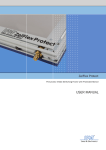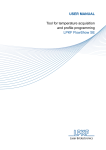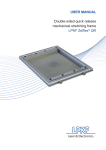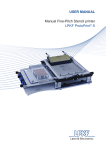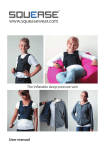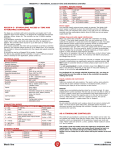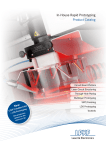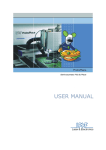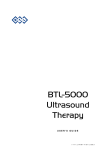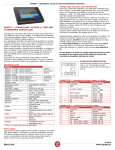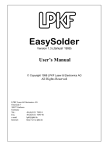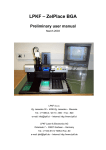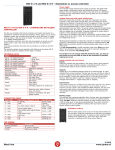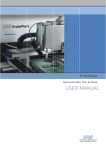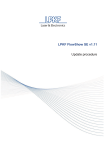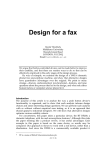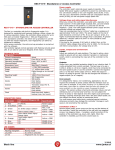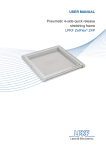Download LPKF Vacuum Table, User manual, ENG, v1.03
Transcript
USER MANUAL LPKF Vacuum Table Introduction 1Introduction Company name: Abbreviated name: Address: LPKF Laser & Electronics d.o.o. LPKF d.o.o. Polica 33 SI-4202 Naklo Slovenia Telephone: Fax + 386 (0) 592 08 800 + 386 (0) 592 08 820 Internet: www.lpkf.com E-mail: [email protected], [email protected] Trade-mark: 1.1 LPKF Vacuum Table The LPKF Vacuum table provides support for rigid and flexible PCBs during printing on the LPKF ProtoPrint S, and placing of components with the LPKF ProtoPlace S or with LPKF ProtoPlace BGA. The design of the vacuum table guarantees easy and free movement of the table between printer and placer without disconnection or interruption of the vacuum. The vacuum table is equipped with special positioning pins, which ensures repeatability of the PCB position, when repeated printing is required. Better linking of the entire SMT process is achieved with the use of a thermo ceramic board which is available as an option. After the placing process is finished, the thermo ceramic board is released and moved into the LPKF ProtoFlow S soldering oven together with the PCB. The LPKF vacuum table provides 100 % support for the PCBs during the entire process of SMT assembly. User Manual v1.03 Rev.: 11.03.2014 3 Introduction 1.2Warnings Copyright© 2011-2012 LPKF d.o.o. Copying and distributing these instructions in their entirety or in part is only permitted by LPKF approval in writing. Note: Data can be altered without prior notice. Original Instructions LPKF is not liable for any damage occurring due to improper use of these instructions. The owner of the LPKF device is obligated to: • • • • • • Ensure that the device is used only for its intended purpose. Ensure that the device is used only under the specified operating conditions. Regularly check safety, and control devices. Ensure that only authorised and qualified personnel operate the device. Ensure that all operators of the device have ready access to these instructions. Ensure that the device always has safety labels in place. Before opening the packaging, check the »shock sensor« located on the outside of the box. If the indicator is coloured bright red, DO NOT OPEN THE PACKAGING, but immediately inform your transport agent! Remove the packaging and check the general state of the equipment, and check the contents against the enclosed packing list. In the event of any damage immediately inform the transport agent! Before starting-up the device, remove all packaging, which served as protection of the device during transport, otherwise severe damage could be caused to the device! Please note: unauthorised repairs or modifications to the equipment will void the warranty! In case of problems with the machine, please immediately contact us, giving the serial number of the machine! Telephone: + 386 (0) 592 08 800 Fax: + 386 (0) 592 08 820 E-mail: 4 [email protected] [email protected] Rev.: 11.03.2014 LPKF Vacuum Table Contents 2Contents 1Introduction 1.1 LPKF Vacuum Table 1.2Warnings 3 3 4 2Contents 2.1 Symbols etc. used in this manual 2.1.1 Registered trademarks 5 7 3 Basic data 3.1Name and address of the manufacturer 3.2 Relevant model 3.3 Intended use 3.4 Technical data 3.5Noise level/vibration/emission of hazardous chemicals 8 8 8 8 8 9 4 Safety notes 4.1 General 4.2Hazards 4.3 Safety measures 4.4 Procedures in the event of injury or other emergencies. 10 10 10 11 11 5Device description 5.1 Basic parts 5.1.1Housing 5.1.2 Supporting plate 5.1.3 Vacuum pump 5.1.4 Air flow regulator 5.1.5 Air valve 5.1.6 Rubber sealant 5.1.7 Positioning pins 5.2 Extra equipment (option) 5.2.1 Vacuum Pump (option) 5.2.2 Thermo ceramic board 5.2.3 Air supply unit (option) 12 12 6Installation 6.1Opening the packaging 6.2 Air connection 6.3 Installation on LPKF ProtoPrint S 6.4 Installation on LPKF ProtoPlace S 6.5 Installation on LPKF ProtoPlace BGA 6.6 Inserting the thermo ceramic upper plate into an oven 17 17 17 18 19 20 21 7 7.1 7.2 7.3 22 22 22 23 Instructions for use Restricting the area of the Vacuum Table Reduction of air consumption Use of the LPKF Vacuum Table 7.3.1Preparation 7.3.2Use 8Maintenance 8.1Cleaning of the Vacuum Pump 8.2Cleaning of the Vacuum Table User Manual v1.03 Rev.: 11.03.2014 14 24 24 24 5 Contents 9 Troubleshooting 25 10Appendices 10.1 Scope of delivery 6 26 26 Rev.: 11.03.2014 LPKF Vacuum Table Contents 2.1 Symbols etc. used in this manual Text in italics emphasises the importance of the information. Symbols that you will notice in some chapters have the following meaning: Danger! The symbol is used to highlight danger to life or health. Caution! The symbol warns of circumstances that could threaten the safety and health of the device operator or cause a serious device defect. Good advice and instruction “Rapido” warns us of possible faults, and recommends simple and effective solutions. 2.1.1 Registered trademarks The LPKF logo and all LPKF product brand names are registered trademarks of LPKF Laser & Electronics AG and LPKF Laser & Electronics d.o.o. All other trademarks are property of their respective owners. User Manual v1.03 Rev.: 11.03.2014 7 Basic data 3 Basic data 3.1 Name and address of the manufacturer Company name: Abbreviated name: Address: LPKF Laser & Electronics d.o.o. LPKF d.o.o. Polica 33 SI-4202 Naklo Slovenia Telephone: Fax + 386 (0) 592 08 800 + 386 (0) 592 08 820 Internet: www.lpkf.com E-mail: [email protected], [email protected] Trade-mark: 3.2 Relevant model LPKF Vacuum Table 3.3 Intended use The LPKF vacuum table is used for fast and easy clamping of rigid and flexible PCBs. It can be used on the LPKF ProtoPrint S, on the LPKF ProtoPlace S and on the LPKF ProtoPlace BGA. If the thermo ceramic board option is purchased, it can also be used with the LPKF ProtoFlow oven. The vacuum table guarantee simple linking up of the entire SMT assembly process. 3.4Technical data Max. size of PCB Max. feed pressure Operating feed pressure Optimum feed pressure Air consumption Air consumption at optimum feed pressure Vacuum Dimensions (W x L x H) Weight Ambient conditions 8 230 x 297 mm (9” x 11.7”) 7 bar (0.7 MPa) 1.7 - 6 bar (0.17 - 0.6 MPa) 3 bar (0.3 MPa) 0.3 - 0.8 l/s 0.5 l/s 0.2 bar (0.02 MPa) 270 x 297 x 22.5 mm (10.6” x 11.7” x 0.9”) 4 kg (8.8 Ibs) Temperature: -10 - +50 ºC (14 - 122 ºF) Rev.: 11.03.2014 LPKF Vacuum Table Basic data 3.5 Noise level/vibration/emission of hazardous chemicals The noise and vibration levels of the device during operation are not harmful to health. Contact with chemicals (soldering pastes) is possible during work process with the LPKF Vacuum Table. Soldering pastes can contain hazardous chemicals. Verify data on the type of the substance and dangerous characteristics of the substance on the packaging or on the safety data sheet. Soldering paste can contain lead! Please ensure that the prescribed safety measures, stated in the paste manufacturer’s instructions, are observed. Any advice concerning personal protective equipment should also be followed! User Manual v1.03 Rev.: 11.03.2014 9 Safety notes 4 Safety notes Before using the device, carefully read this chapter on health and safety. Familiarise yourself with potential risks and prescribed safety precautions. 4.1General 1. 2. 3. 4. 5. 6. The device must be installed in accordance with the installation instructions. The device should only be used for its designated purpose. A suitable working environment must be ensured. The device may only be operated by qualified personnel. Servicing can only be performed by authorised and qualified personnel. Ready access to the “User Manual” must be provided to all device operators. 4.2Hazards BURNS There is a risk of burns when taking the thermo ceramics upper plate out of the oven. MECHANICAL During operation, a disconnected air hose can cause serious HAZARDS injury (direct impact into the body). 10 CHEMICAL HAZARDS Soldering pastes can contain substances that are hazardous to health. SENSOR STRESS In the event of unsuitable general lighting of the area the operator can experience an increase of sensor stress. MANUAL HANDLING The weight of the device is 4 kg / 8.8 lbs. Dropping the device could cause serious injury to legs and feet. Rev.: 11.03.2014 LPKF Vacuum Table Safety notes 4.3 Safety measures Before operating the device a full visual inspection should be carried out. In the event of any defects or malfunctions work must not be started until all faults have been corrected! It is of vital importance that the area around the device is maintained clean and tidy. A disorganised work-place can cause occupational injuries (i.e. a person can fall, slip or receive an injury.). Please ensure that the environment in which the equipment is going to be used conforms to that specified in this document. While working with the device the complete attention of the operator is required. A person, who is feeling unwell or is having difficulties concentrating, should not operate the device! Only equipment, which has been approved by LPKF can be used in conjunction with the device. The use of unsuitable equipment could endanger the operator! Repairs can only be performed by authorised service personnel. These personnel should ensure that the safety of the equipment is not compromised by the repair. The storing or consuming of food and drinks in the work area is forbidden! Smoking is forbidden! When using hazardous substances, safety data sheet instructions and advice should be followed! After completing work the device should be turned off (air supply) and cleaned. Recommended personal protective equipment: protective gloves. 4.4 Procedures in the event of injury or other emergencies. Emergency disconnection is possible by turning off the power switch. In the event of a work-related injury, stop the device immediately, and if necessary seek professional medical assistance. User Manual v1.03 Rev.: 11.03.2014 11 device description 5Device description 5.1 Basic parts Support plate Vacuum pump Blocking plug Air flow regulator Clamp Housing 5.1.1Housing The housing contains the vacuum chamber, and supports and clamps the upper plate. Channels within the housing enable the size, shape, and position of the vacuum chamber to be adjusted to suit the PCB. Up to two vacuum pumps can be fitted to the unit. 5.1.2 Supporting plate The housing contains the vacuum chamber, and supports and clamps the upper plate. Channels within the housing enable the size, shape, and position of the vacuum chamber to be adjusted to suit the PCB. Up to two vacuum pumps can be fitted to the unit. 5.1.3 Vacuum pump The vacuum pump is easily upgradeable and replaceable. Max. efficiency of the vacuum pump is achieved at 3.14 bar (0.314 MPa; see chapter 5.2.1). 12 Rev.: 11.03.2014 LPKF Vacuum Table device description 5.1.4 Air flow regulator Air flow regulator, mounted on the housing, regulates the range of vacuum. 5.1.5 Air valve The air valve is used for opening and closing the air supply. The air valve could be fitted on special holder and placed near the vacuum table. 5.1.6 Rubber sealant The rubber seals are designed to increase the efficiency of the vacuum chamber, reduce the lose of vacuum and to decrease the evacuation time of the vacuum chamber. 5.1.7 Positioning pins Insert the position pins into the holes on the upper support plate to assure the repetition of placement of the PCB. User Manual v1.03 Rev.: 11.03.2014 13 device description 5.2 Extra equipment (option) 5.2.1 Vacuum Pump (option) Use an extra Vacuum Pump to increase the range of created vacuum and better fixation of the PCB. Instalation: 1. Remove the upper support plate out of the housing. 2. Remove the blocking plug (use the screwdriver): 3. Remove the extra vacuum pump out of the package: 4. Install the extra vacuum pump into the housing: 5. Assemble back the upper support plate: 14 Rev.: 11.03.2014 LPKF Vacuum Table device description 5.2.2 Thermo ceramic board A high temperature resistant ceramic plate is an available option. With this plate, flexible flex prototypes can be directly transferred into the LPKF ProtoFlow reflow oven. This ceramic plate can be used for holding the PCB through the printing, pick & place, and soldering processes. After the placing process is finished, the thermo ceramic board is released from the vacuum table and moved into the LPKF ProtoFlow soldering oven together with flex PCB. The board can be used several times Use the thermo ceramics plate for printing, placing and soldering flexible PCB’s Installation: 1. Release and remove the upper support plate from the housing: 2. Insert the thermo ceramics upper plate (option): 3. Insert the special positioning pins (option) and connect the air valve to the vacuum table and the air valve in turn with your air supply unit: User Manual v1.03 Rev.: 11.03.2014 15 device description 5.2.3 Air supply unit (option) For easy and reliable air distribution an optional air pressure regulator with water separator and 5 μm filter can be mounted on a stand for clamping to the edge of a table. 16 Rev.: 11.03.2014 LPKF Vacuum Table installation 6Installation 6.1Opening the packaging Before opening the packaging, check the »shock sensor« located on the outside of the cardboard box. If the indicator is coloured bright red, DO NOT OPEN THE PACKAGING, but immediately inform your transport agent! The picture shows the LPKF Vacuum Table equipped with an optional vacuum pump and an optional air supply unit. 6.2 Air connection 1. Connect the air valve with the Vacuum Table. 2. Connect the air valve with an air supply unit. 3. Air supply requirements: 3 - 6 bar (0.3 - 0.6 MPa) The air valve must be closed before connection of the air hose to the air supply unit. 4. Open the air valve: User Manual v1.03 Rev.: 11.03.2014 17 installation 6.3 Installation on LPKF ProtoPrint S 1. Place the LPKF Vacuum Table the upper plate of the ProtoPrint S. 2. Fix the Vacuum Table with the Allen screws enclosed with the ProtoPrint S. The Vacuum Table must be placed so that the vacuum pump is pointing to the right. 3. Fix the air valve on the side of the ProtoPrint S. 4. Connect the air valve with the air supply. 5. Open the air valve. 18 Rev.: 11.03.2014 LPKF Vacuum Table installation 6.4 Installation on LPKF ProtoPlace S 1. Place the Vacuum Table on the ProtoPlace S micro-table so that the channels on the underside of the vacuum table fit over the rails on the micro-table. The vacuum pump must be pointed to the right. 2. Connect the air valve with the air supply unit. 3. Open the air valve User Manual v1.03 Rev.: 11.03.2014 19 installation 6.5 Installation on LPKF ProtoPlace BGA 1. Remove the flexible steel supporting lath from the BGA Vacuum Table. 2. Fix the Vacuum Table on the BGA table with two Allen screws. 3. Place the air valve on the supporting steel lath of the BGA table. 4. Connect the air valve with an air supply unit. 5. Open the air valve. 20 Rev.: 11.03.2014 LPKF Vacuum Table installation 6.6 Inserting the thermo ceramic upper plate into an oven 1. Release the thermo ceramics plate from the housing (release the clamps). 2. Insert the plate (with the PCB) into an oven: 3. Start the process of soldering. After the process of soldering the thermo ceramic upper plate can be hot – risk of burns! Use protective gloves when removing the plate from the oven. User Manual v1.03 Rev.: 11.03.2014 21 instructions for use 7 Instructions for use 7.1 Restricting the area of the Vacuum Table 1. Insert the rubber seals into the grooves in the housing. 2. Place the PCB on the surface. 3. Mark the area around the PCB. 4. Cut the seals where marked. 5. Place the seals back into the housing. 6. Replace the upper plate of the Vacuum Table. 7.2 Reduction of air consumption When the PCB is firmly placed on the upper plate the air consumption can be reduced by reducing the air supply with the air flow regulator. The vacuum pump will provide a sufficient vacuum even with partially closed speed controller. 22 Rev.: 11.03.2014 LPKF Vacuum Table instructions for use 7.3 Use of the LPKF Vacuum Table 7.3.1Preparation 1. Install the Vacuum Table on the machine (ProtoPrint S, ProtoPlace S or ProtoPlace BGA). 2. Restrict the area of the vacuum table (chapter 7.1). 3. Connect the air supply hose to the air flow regulator. 7.3.2Use 1. Place the PCB onto the restricted area. 2. Insert the Positioning pins. 3. Lay the PCB upon the pins. 4. Open the air supply, the vacuum pump is activated and vacuum is created in a few seconds. 5. Check that there is no venting of the vacuum from the holes surrounding the PCB a reconfigure the vacuum chamber (chapter 7.1). 6. Start printing on LPKF ProtoPrint S, or placing on LPKF ProtoPlace S or LPKF ProtoPlace BGA. User Manual v1.03 Rev.: 11.03.2014 23 maintenance 8Maintenance 8.1Cleaning of the Vacuum Pump 1. Remove the vacuum pump from the housing and unscrew the vacuum pump. Do not use any tools! 2. Remove the filter from the vacuum pump 3. Soak the filter into a mild cleanser solution and rub it with fingers. 4. Wash the filter under water. 5. Dry the filter (use compressed air). 6. Replace the filter on the vacuum pump. 7. Screw the vacuum pump into the housing (clockwise rotation). Do not use any tools! 8.2Cleaning of the Vacuum Table The Vacuum Table is easily cleaned with a damp cloth soaked in a mild detergent solution. Soldering pastes have to be cleaned in accordance with manufacturers’ instructions regarding each individual substance. Most soldering pastes and glues can be cleaned using isopropyl alcohol. The surface of the oven can be easily cleaned with a soft cloth, soaked in a mild detergent solution. 24 Rev.: 11.03.2014 LPKF Vacuum Table troubleshooting 9Troubleshooting Before any intervention in the device, first disconnect the device from the mains power system. In some cases you can correct a fault in device operation yourself following the guidelines stated below. In the event that you do not succeed do not continue with any repairs, but immediately contact an authorised serviceman/distributor of LPKF devices. Fault/Defect Procedure Check the vacuum on the air supply unit. Check the air hoses. Check the air valve Vacuum pump is not working Air supply failure. (regularity of connection of air hoses). Check the speed controller (must be open). Vacuum Pump is not working, Vacuum Pump is not fitted Check the fitting of the no failure on the air supply. into the housing properly. vacuum pump. The range of air supply is too Check the range of air in the low. air supply system. The vacuum pump filter is Clean the vacuum pump stopped. filter. The vacuum is too low. The exhaust of vacuum pump Remove any debris from the is blocked. exhaust of the vacuum pump. Check the clamps holding Mounting of the upper the upper support plate to the support plate failure. housing. User Manual v1.03 Cause Rev.: 11.03.2014 25 Appendices 10Appendices 10.1 Scope of delivery Air hose, 2 x 2 m Air valve Rubber seals, 2 m Positioning pins, 2 x 3 pcs User Manual 26 Rev.: 11.03.2014 LPKF Vacuum Table



























